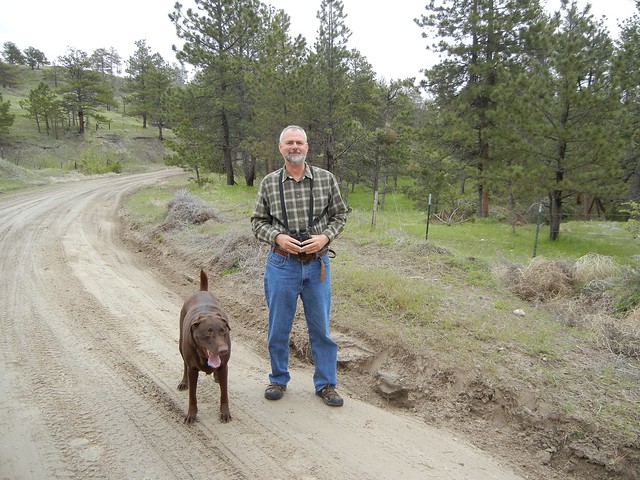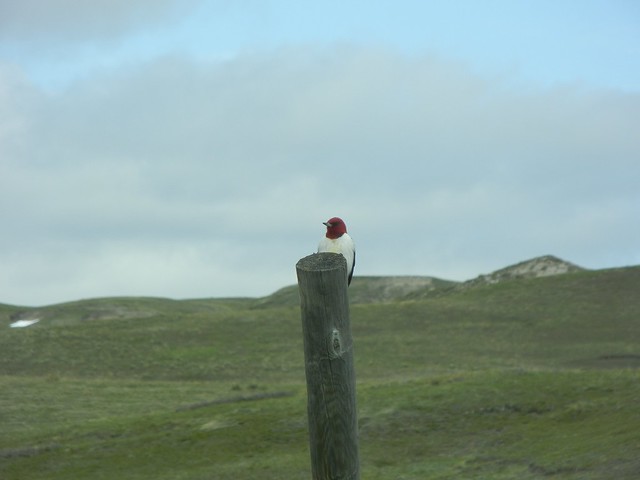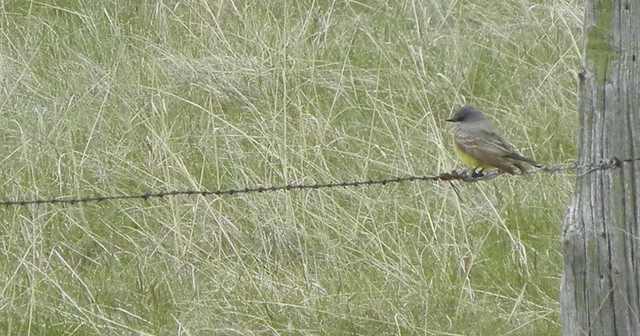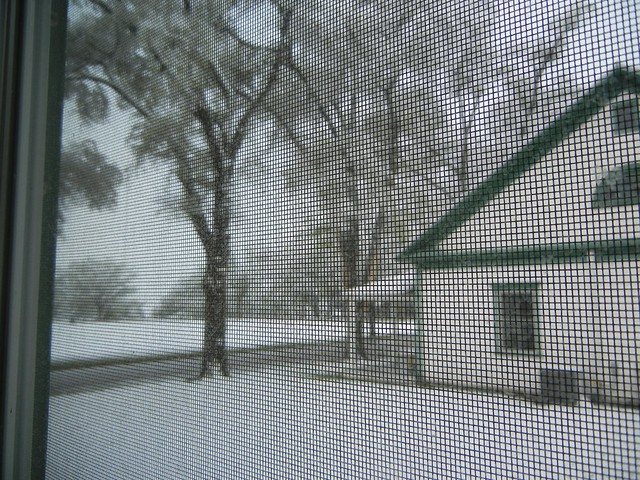
Much of the snow melted by 2:00 pm.
It’s one of those sentences I didn’t expect to speak on May 20 in Nebraska, but snow it did, a good inch and a half on the ground, the roofs, and the car tops when we got up that morning.
And what do we do in unexpected weather in migration? We bird, of course.
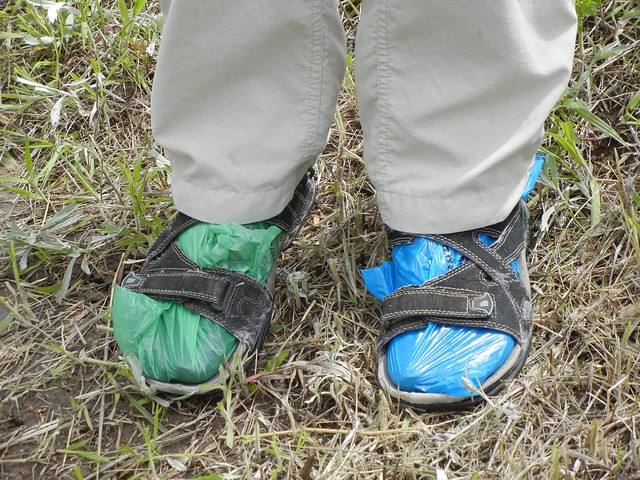
Alison’s attire required a little extemporization, but once that was done, we set off for the Soldiers Creek Campground at Fort Robinson, where we’d seen large numbers of lark sparrows, clay-colored sparrows, chipping sparrows, and lazuli buntings the day before, when it was just drizzling.
This snowy morning, the campground came through for us once again.

It’s always been one of my favorite birding sites in one of my favorite landscapes, the Nebraska Pine Ridge, but it’s rare for me to be there when the campers aren’t. On this morning, we shared the wooded grounds along the creek with a grand total of one rv’er (uncertain how to spell that one) — and loads and loads of birds.
Most impressive of all were the Swainson’s thrushes. This is a common May migrant in the Nebraska Panhandle, but we were unprepared for the flock of at least 20 bouncing around on the lawns and in the brush. We looked hard for rarer birds, but all were Swainson’s, and all the Swainson’s were olive-backed thrushes. No complaints from us, though.
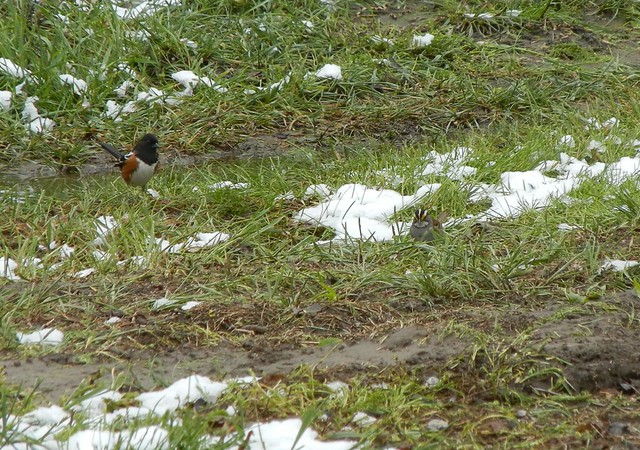
The sparrow flock had grown considerably in numbers, with at least 120 lark sparrows feeding frantically on the snow, and perhaps half that many chipping sparrows joining in. Spotted towhees, probably but not certainly local breeders, whined and mewled and trilled everywhere, occasionally bounding out from their thickets to show off. These arcticus birds are the most heavily marked of all the spotted towhees, and Alison, who had most recently seen the bland oregonus birds of coastal British Columbia, exclaimed again and again when one flashed through her field of view.
There were less expected sparrows, too. A Lincoln’s sparrow was a bit on the latish side, even for western Nebraska, and a gloriously white-striped white-throated sparrow was both geographically and chronologically slightly out of place: generally uncommon at best in the Panhandle, this species is usually gone from the state entirely by May 20.
Most interesting among the emberizids were the white-crowned sparrows. At first glance, they seemed all to be dark-lored birds, thus presumably leucophrys (or maybe, just maybe, oriantha); but a closer look revealed that even though the black lateral crown stripes were thick and reached or nearly reached the base of the bill, there was invariably a gray loral patch separating that stripe from the eye line. The bill color was also intermediate between the darker-billed birds of the far north and west and the paler-billed Gambel’s sparrow; we put them down as “subspecies indeterminate,” not an uncommon label when you’re dealing with migrants — of just about any species — on the western Great Plains.
A high-pitched squeal revealed another surprise.
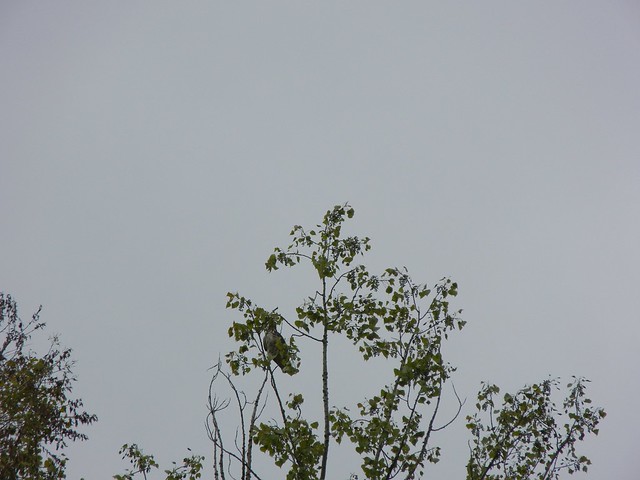
Broad-winged hawks are rare in extreme western Nebraska, but the weather had put down a mini-flock of three juveniles in the campground’s cottonwoods, and as the weather warmed, slightly, they took to the air, flashing from tree to tree and studiously avoiding the nervous Cooper’s hawks nesting in a tall tree nearby.
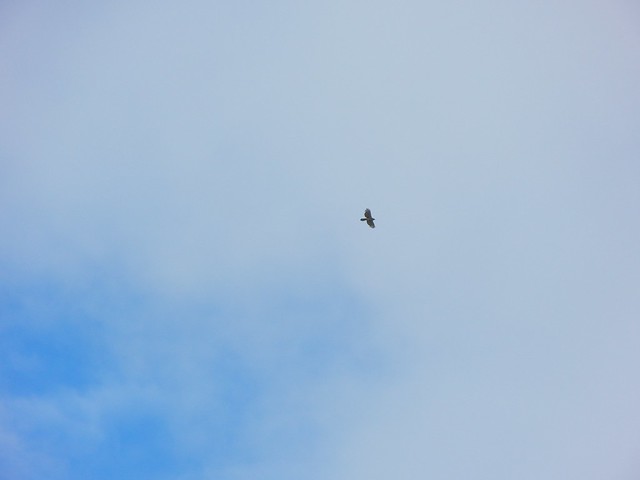
If I were a county lister, I’d have checked this one off for two, as it soared against the Cheyenne Outbreak Buttes, back and forth across the Sioux County line.
Meanwhile, the passerine show never let up. Red-eyed vireos and a locally scarce Bell’s vireo sang from the trees and thickets, and as the air attained its balmy 40 degrees F, yellow warblers, common yellowthroats, American redstarts, and an ovenbird started to hunt and sing. All of those species breed in the campground, but there were also two migrants: a nice-looking celata orange-crowned warbler, and then, feeding with the American goldfinches and pine siskins in the cottonwood buds, a grassy-backed Tennessee warbler. As abundant as that bird is in eastern Nebraska in May, I’d never seen it in the Panhandle, where it is surprisingly rare at any season.
Three hours later, we left the campground to explore a couple of other sites.
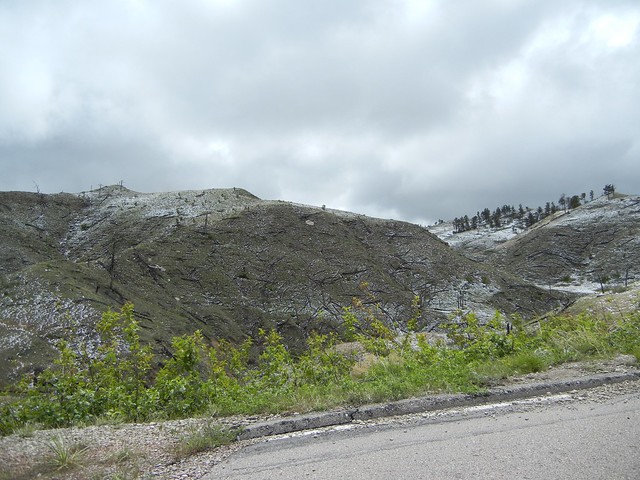
There were birds everywhere, but the true fallout seemed to be concentrated in the riparian thickets. Up in Smiley Canyon, where our way was first blocked by American bison, we found no obvious migrants at all, though a flock of seven black-billed magpies was a welcome sight — the only representatives of the species we would see anywhere in Nebraska. The Icehouse Ponds were slightly more productive, with numbers of Swainson’s thrushes plicking and plocking everywhere we turned; chimney and white-throated swifts hunted among the flock of cliff, barn, and violet-green swallows. Alison, less reverent of rarity and more easily swayed by mere beauty than I am sometimes, decided that a male Bullock’s oriole, perched out on the grass in the middle of a small flock of western kingbirds, was her favorite bird of the day.
And mine? Impossible to choose on a day like this, when the weather and the season combined to make one of the best birding experiences I’d had in a long time. Or at least since the day before.

